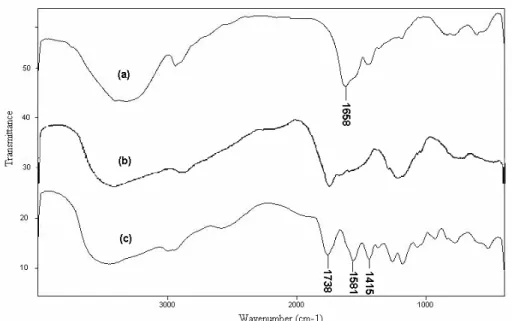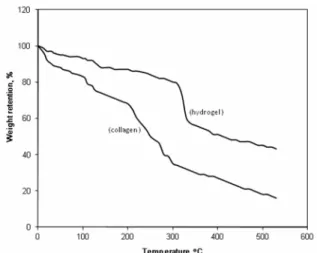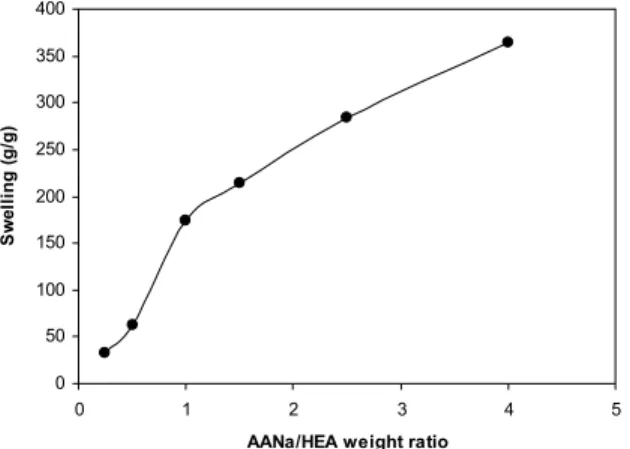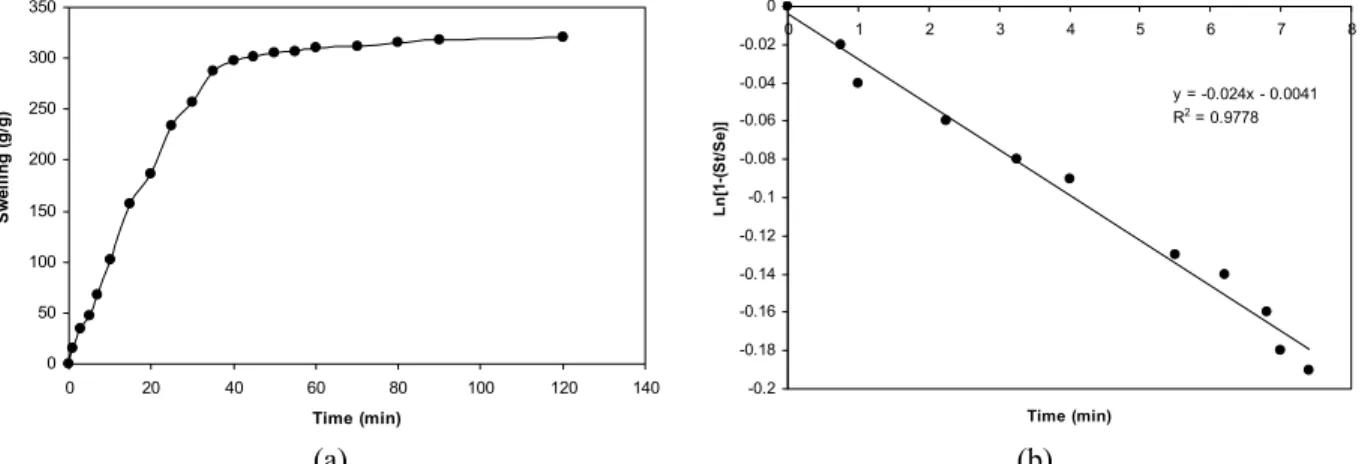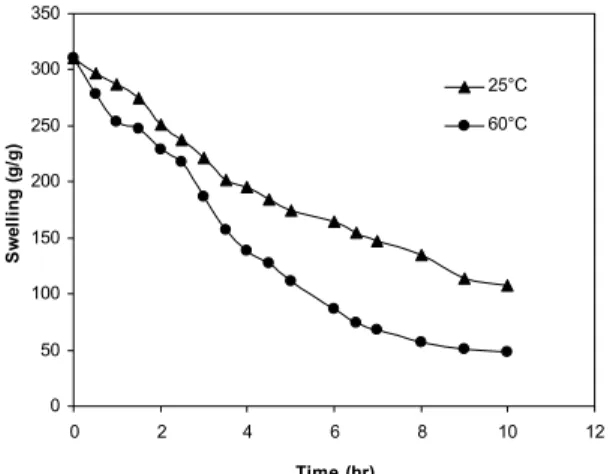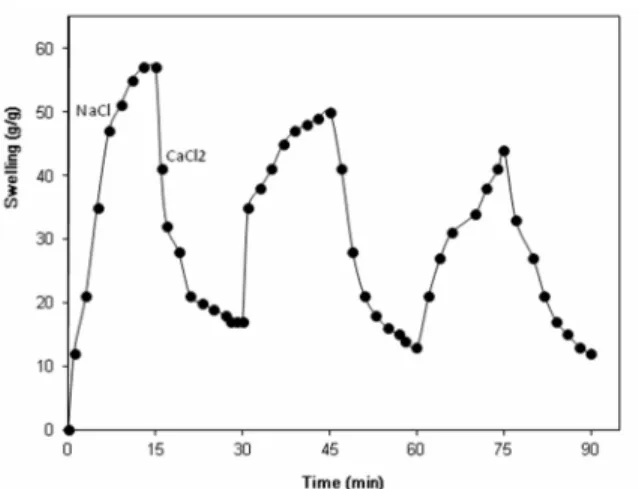ISSN 0104-6632 Printed in Brazil
www.abeq.org.br/bjche Vol. 30, No. 02, pp. 379 - 389, April - June, 2013
Brazilian Journal
of Chemical
Engineering
SYNTHESIS AND PROPERTIES OF
COLLAGEN-
g
-POLY(SODIUM ACRYLATE-
co
-2-HYDROXYETHYLACRYLATE)
SUPERABSORBENT HYDROGELS
M. Sadeghi
1*and H. Hosseinzadeh
21Chemistry Department, Science Faculty, Islamic Azad University, Phone: + 98-861-4130037, Fax: + 98-861-413227, Arak Branch, Arak, Iran.
E-mail: m-sadeghi@iau-arak.ac.ir 2
Chemistry Department, Payame Noor University, P.O. Box 19395-4697, Tehran, Iran.
(Submitted: January 17, 2011 ; Revised: November 20, 2011 ; Accepted: July 31, 2012)
Abstract - Novel biopolymer-based superabsorbent hydrogels were prepared by grafting crosslinked poly(acrylic acid-co-2-hydroxyethyl acrylate) (PAA-co-PHEA) chains onto collagen backbones through a free radical polymerization method. The graft copolymerization reaction was carried out in a homogeneous medium and in the presence of ammonium persulfate (APS) as initiator and N,N'-methylene bisacrylamide (MBA) as crosslinker. A proposed mechanism for collagen-g-(PAA-co-PHEA) formation was suggested and the hydrogel structure was confirmed using FTIR spectroscopy and TGA thermal analysis. Moreover, the morphology of the samples was examined by scanning electron microscopy (SEM). The effect of concentration of MBA as well as AA/HEA weight ratio on the swelling capacity of the hydrogel was also studied. Furthermore, the water absorbency of hydrogels was measured in solutions with pH ranging 1 to 13. The collagen-based hydrogel exhibited a pH-responsive character, so that a swelling-deswelling pulsatile behavior was recorded at pHs 2 and 8. Preliminary swelling and deswelling behaviors of the hydrogels were also studied. Additionally, the hydrogels exhibited salt-sensitivity and cation exchange properties.
Keywords:Collagen; Hydrogels; Swelling; Acrylic acid; 2-hydroxyethyl acrylate.
INTRODUCTION
In recent years, much interest has been shown in the development of the synthesis of natural-based superabsorbent hydrogels (Bagheri Marandi et al., 2011; Hua and Wang, 2009; Sadeghi and Hosseinzadeh, 2010; Zhang et al., 2007; Wang et al., 2009; Zheng and Wang, 2009; Chen et al., 2009). These biopolymer materials are crosslinked hydro-philic polymers, capable of absorbing large quantities of water, saline or physiological solutions (Buchholz and Graham, 1997; Peppas and Harland,
1990). Because of their non-toxicity, biocompatibility and biodegradability, natural-based hydrogels have attracted attention in many fields such as personal hygiene and cosmetics (Zhou et al., 2011; Sokker et al., 2011; Huixia et al., 2010; Raghavendra et al., 2010; Hoffman, 2002; Pourjavadi et al., 2009).
and Wang, 2010; Yu et al., 2006).
The modification of natural polymers is a promising method for the preparation of new materials. An efficient approach to modify natural polymers, in order to obtain natural-based su-perabsorbent hydrogels, is graft polymerization of vinylic monomers onto their backbones in the presence of crosslinkers. Free radical graft copoly-merization with various monomers can be carried out with different initiator systems.
Proteins are widely distributed in nature and are synthesized mainly in animals, i.e., collagen, keratin, etc., and in some plants such as Soya. In general, proteins are high molecular weight polymers and their solubility in aqueous solutions is difficult. Two efficient methods for the preparation of aqueous soluble proteins are alkaline and enzymatic hydrolysis. According to a literature survey based on Chemical Abstracts Service, a few studies have been reported in the case of protein-based hydrogels (Zohuriaan-Mehr et al., 2009; Branco et al., 2010; Yin et al.,
2008, Rathna and Damodaran, 2002; Yan et al.,
2006; Pourjavadi and Kurdtabar, 2007). Hence, in this work, we describe the preparation and charac-terization of a hydrolyzed collagen-g-poly(acrylic acid-co-2-hydroxyethyl acrylate) hydrogel as a new natural- based polymer with pH-responsiveness properties. In this hydrogel, 2-hydroxyethyl acrylate is used as a co-monomer mainly for increasing the hydrophilicity of the resulted network.
EXPERIMENTAL
Materials
Hydrolyzed collagen (Parvar Novin-E Tehran Co.) was industrial grade available on the market and contained nearly 25% insoluble phosphate salt. Acrylic acid and 2-hydroxyethyl acrylate (Merck, Darmstadt, Germany) were used after vacuum distillation. N',N'-Methylene bisacrylamide and am-monium persulfate (Fluka, Buchs, Switzerland) were of analytical grade and used without further purification. All other chemicals were also analytical grade. Double distilled water was used for the hydrogel preparation and swelling measurements.
Preparation of Hydrogel
A pre-weighed amount of hydrolyzed collagen (2.0 g) was dissolved in 50 mL of distilled water and filtered to remove the insoluble phosphate salt. Then the solution was added to a 1-L reactor equipped
with a mechanical stirrer (RZR 2021, a three-blade propeller type, Heidolph, Schwabach, Germany) and stirred (300 rpm) for 10 min. The reactor was placed in a thermostated water bath to control the reaction temperature at 80 °C. Then, acrylic acid (1.0-4.0 g, completely neutralized with sodium hydroxide), 2-hydroxyethyl acrylate (4.0-1.0 g), ammonium persulfate (0.1 g, dissolved in 5 mL water) and methylene bisacrylamide (0.05-0.20 g, dissolved in 5 mL water) were added simultaneously to the reactor. The temperature was maintained at 80 °C and the reaction mixture was stirred continuously (300 rpm) for 1 h. At the end of the propagation reaction, the gel product was poured into ethanol (300 mL) and was dewatered for 12 h. Then, the product was cut into small pieces, washed with 200 mL of ethanol and filtered. The particles were dried in an oven at 50 °C for 12 h. After grinding, the powdered superabsorbent composite was stored in absence of moisture, heat and light.
Swelling and Deswelling Measurements
An accurately weighed sample (0.20 g) of the powdered superabsorbent with average particle sizes between 40-60 mesh (250–350 μm) was immersed in distilled water (200 mL) or the desired salt solution (100 mL) and allowed to soak for 3 h at room temperature. The swelling capacity (SC) was measured twice at room temperature according to a conventional tea bag (i.e., a 100 mesh nylon screen) method (Zohuriaan-Mehr and Pourjavadi, 2003) using the following formula:
(
)
(
s d)
dSC g / g = W – W / W (1)
where Ws = weight of swollen gel and Wd = weight
of dried gel.
The deswelling water ratio of each sample was evaluated from the following equation:
t t0
W
Deswelling water ratio (%) 100
W
= × (2)
where Wt0 and Wt are the initial weight of the fully
swollen sample and the weight of sample at the deswelling time, t, respectively.
Absorbency at Various pHs
Individual solutions with acidic and basic pHs were prepared by dilution of NaOH (pH 10.0) and
Synthesis and Properties of Collagen-g-Poly(Sodium Acrylate-co-2-Hydroxyethylacrylate) Superabsorbent Hydrogels 381
pH<6.0, respectively. The pH values were precisely checked with a pH-meter (Metrohm/620, accuracy ±0.1). Then, 0.5 g (± 0.001 g) of the dried hydrogel was used for the swelling measurements according to Equation (1). To study the pH-reversibility of the hydrogels, solutions with pH 2.0 and 8.0 were used. Swelling capacity of the hydrogels at each pH was measured according to Equation (1) at consecutive time intervals (30 min).
Swelling Kinetics
For studying the rate of absorbency of the hydrogels, a certain amount of sample (0.5 ± 0.001 g) was poured into weighed tea bags and immersed in 200 mL of distilled water. At consecutive time intervals, the water absorbency of the hydrogels was measured according to the above mentioned method.
Instrumental Analysis
Fourier transform infrared (FTIR) absorption spectra of samples were measured in KBr pellets, using an ABB Bomem MB-100 FTIR spectropho-tometer (Quebec, Canada), at room temperature, with an average of 64 scans at 4 cm−1 resolution. The sample/KBr ratio was 0.5% and the IR peak signal-to-noise ratio was typically 30,000:1 for a 1 min scan time. The surface morphology of the gel was examined using scanning electron microscopy (SEM). Dried superabsorbent powder was coated with a thin layer of palladium gold alloy and imaged in a SEM instrument (Leo, 1455 VP). Brunauer– Emmett–Teller (BET) analysis was performed with Surface Area and Pore Size Analyzers (NOVA-e
Series, Autosorb™-6B) to determine the pore size of the hydrogels.
RESULTS AND DISCUSSION
Synthesis and Spectral Characterization
Scheme 1 shows a simple structural proposal of the graft copolymerization of AANa and HEA onto the collagen backbones and crosslinking of the graft copolymer. In the first step, the thermally dissociating initiator, i.e. APS, is decomposed under heating (80 °C) to produce sulfate anion-radicals. Then the anion-radicals abstract hydrogen from the collagen backbone to form the corresponding macroinitiators. These macroradicals initiate grafting of AANa and HEA onto the collagen backbone, leading to a graft copolymer. Crosslinking reactions also occurred in the presence of the crosslinker, i.e., MBA.
FTIR spectroscopy was used for identification of the hydrogel. Figure 1 shows the IR spectra of the collagen and the resulted hydrogel. The band
observed at 1658 cm-1 can be attributed to C=O
stretching in carboxamide functional groups of the substrate backbone (Figure 1(a)). The broad band at 3200-3600 cm-1 is due to stretching of –OH groups of the collagen. In the spectra of the hydrogel (Figure
1(c)) the characteristic band at 1581 cm-1 was
attributed to C=O asymmetric stretching in the carboxylate anion. This was confirmed by another peak at 1415 cm-1, which is related to the symmetric stretching mode of the carboxylate groups. The main contribution to the absorption band at 1738 cm-1 is from the ester group of poly (2-hydroxyethyl acrylate).
SO4
.-S2O8
-HSO4
-NH
O O
HN
(MBA)
COONaHN O
HN
AANa O
N H HN
(another polyacrylic chains)
crosslinked collagen-g-(PAANa-co-PHEA)
O
C
O
O
O
NH
R n
protein
backbone proteinbackbone
COONa CO2CH2CH2OH
CO2CH2CH2OH
COONa
-(AANa) (HEA)
O
O OH
HEA
2
-80
(R: various chains of 20 different amino acid)
protein backbone
+
,
Figure 1: FTIR spectra of collagen (a), hydrogel without collagen (b) and collagen-g-(PAA-co-PHEA) hydrogel (c).
Figure 1(b) shows the FTIR spectrum of the hydrogel without collagen. The band at 1658 cm-1 attributed to the amide groups of collagen backbone in Figure 1(a) was not observed in Figure 1(b). This proves that the grafting reaction between collagen and monomers effectively occurred.
To obtain additional evidence of grafting, a similar polymerization was conducted in the absence of the crosslinker. After extracting the homopoly-mers, PAA or PHEA, and unreacted monomers using a cellophane membrane dialysis bag (D9402, Sigma–Aldrich), an appreciable amount of grafted collagen (83%) was observed. The graft copolymer spectrum was very similar to Figure 1(c). Also, according to preliminary measurements the sol (soluble) content of the hydrogel networks was as little as 1.6%. This fact practically proves that all HEA and AA are involved in the polymer network. Thus, the monomer percent in the network will be very similar to that of the initial feed of reaction.
The percentage of grafting efficiency (%Ge) was evaluated with the following weight-basis equation (Fanta, 1973):
Monomers grafted
%Ge 100
Monomer ch arg ed
= × (3)
The %Ge stands for the grafted monomers formed from the initial monomer charged.
One of the most important properties that must be considered is hydrogel microstructure morphology. Figure 2 shows scanning electron microscope (SEM) photographs of the surface (Fig. 2A) and the cross-sectional area (Figure 2B) of the hydrogel with interconnected pores. The hydrogel has a porous structure. It is supposed that these pores are the regions of water permeation and interaction sites of external stimuli with the hydrophilic groups of the graft copolymers. The cross-sectional view of hydrogels (Figure 2B) also exhibited large, open, channel-like structures.
The results of BET analysis showed that the average pore diameter of the synthesized hydrogel was 8.6 nm. In general, the size of the pores can be controlled by adjusting the various factors such as the type and amount of surfactant, porosigens and gas forming agent during crosslinking polymeriza-tion, and the amount of diluent in the monomer mixture (i.e., monomer–diluent ratio). For example, as the amount of diluent (usually water) in the monomer mixture increases, the pore size also increases up to the micrometer (μm) range (Chirila et al., 1993).
Synthesis and Properties of Collagen-g-Poly(Sodium Acrylate-co-2-Hydroxyethylacrylate) Superabsorbent Hydrogels 383
reacts with its surroundings via its surface. A higher surface area material is more likely to react faster, dissolve faster and adsorb more gas than a similar material with a lower surface area (Tremaine and Gray, 1976; Zhang et al., 2010; Khan and Bilgainya, 2011).
Figure 2: SEM photograph of the hydrogel. (A) Surface of porous hydrogel; (B) Cross-sectional area of porous hydrogel. The average pore diameter of the synthesized hydrogel was 8.6 nm.
Thermal Analysis
TGA thermograms of intact collagen and of the cross-linked hydrogel are presented in Figure 3. The observed initial mass loss up to 140 °C may be due to the presence of moisture, solvents, the unreacted cross-linking agents or the monomers and the evaporation of residual water restrained by the hydrophilic interactions in the hydrogels (Paulino et al., 2007). However, no remarkable mass loss occurred at the later stage, i.e., up to 310 °C. In the case of collagen, a sharp mass loss of about 50–55% is observed between 200 and 300 °C and this may be attributed to the loss of the hydroxyl group of collagen as water molecules. For the collagen-g
-(PAA-co-PHEA) hydrogel, mass loss was small
initially, but at a later stage it became constant. However, the grafted and crosslinked hydrogel had a higher mass percentage of about 50% until 340 °C. The percent residual mass of the hydrogel was higher than that observed for collagen at 400 °C. This indicates that modification of collagen by grafting with monomers and crosslinking with MBA renders collagen thermally more stable.
Figure 3: TGA thermograms of collagen and the collagen-based hydrogel.
Effect of MBA Concentration
The effect of crosslinker concentration (Cc) on the
swelling capacity of crosslinked collagen-g -(PAA-co-PHEA) was investigated. As shown in Figure 4, greater values of absorbency are obtained at lower Cc.
y = 1.3317x-1.0875
R2 = 0.9846
0 50 100 150 200 250 300
0.005 0.01 0.015 0.02 0.025 0.03 0.035
MBA (mol/L)
Sw
e
llin
g
(
g
/g
)
In fact, higher Cc decreases the free space
between the copolymer chains and, consequently, the resultant highly crosslinked rigid structure cannot be expanded to hold a large quantity of water. A power law behavior between swelling capacity and MBA concentration (Eq. 4) was obtained from Figure 4.
[
]
nSwelling capacity ≈k MBA− (4)
The k and n in Eq. (4) are constant values for an individual superabsorbent. The n value represents the sensitivity of the hydrogel to the crosslinker content, while the k value is useful for comparing the extent of swelling versus fixed crosslinker content. The values k=1.33 and n=1.09 are obtained from the curve fitted with Eq. (4).
Effect of NaAA/HEA Weight Ratio
The swelling capacity of the superabsorbents as a function of the co-monomer ratio is illustrated in Figure 5. It is known that a high concentration of charged ionic groups in copolymer chains accompanying the increase of NaAA in the hydrogel increases the swelling capacity due to osmosis and charge repulsion. In other words, the presence of more ionic groups in the polymer chains results in increased swelling because the ionic groups are more strongly solvated than non-ionic groups by the aqueous medium.
0 50 100 150 200 250 300 350 400
0 1 2 3 4 5
AANa/HEA weight ratio
Sw
e
llin
g
(
g
/g
)
Figure 5: Effect of monomer ratio on the swelling capacity of the collagen-based hydrogels. Reaction conditions: collagen 2.0 g, MBA 0.05 g, APS 0.1 g, 80 °C, 60 min.
pH-Sensitivity and Pulsatile Behavior
Swelling studies indicated that the ionic hydrogels were sensitive to the environmental pH. Therefore,
in this series of experiments, the swelling ratio for the synthesized hydrogels was measured in different pH solutions ranged from 1.0 to 13.0 (Figure 6). Since the swelling capacity of all "anionic" hydrogels is appreciably decreased by the addition of counter ions (cations) to the swelling medium, no buffer solutions were used. Therefore, stock NaOH (pH 10.0) and HCl (1.0) solutions were diluted with distilled water to reach desired basic and acidic pHs, respectively. Maximum swelling (87 g/g) was obtained at pH 8. In acidic media, most of the carboxylate groups are protonated, so decreased repulsion of anionic groups leads to a decreased swelling ratio. At higher pHs (5-8), some of carboxylate groups are ionized and the electrostatic
repulsion between COO- groups causes an
enhancement of the swelling capacity. The reason for the swelling-loss in the highly basic solutions is the
“charge screening effect” of excess Na+ in the
swelling media, which shields the carboxylate anions and prevents effective anion-anion repulsion.
0 10 20 30 40 50 60 70 80 90 100
0 2 4 6 8 10 12 14
pH
S
w
e
lli
n
g
(
g
/g
)
Figure 6: Effect of pH on the swelling capacity of collagen-g-(PAA-co-PHEA) hydrogel.
The collagen-g-(PAA-co-PHEA) hydrogels also showed reproducible swelling-deswelling cycles at pH 2.0 and 8.0, as demonstrated in Figure 7. At pH 8.0, the hydrogel swells up to 76 g/g due to anion-anion repulsive electrostatic forces, while at pH 2.0, it shrinks within a few minutes due to protonation of the carboxylate groups. The time interval between the pH changes was 15 min. This sharp swelling-deswelling behavior of the hydrogels makes them suitable candidate for controlled drug delivery systems. Such on-off switching behavior via reversible swelling and deswelling has been reported for other ionic hydrogels (Richter et al., 2004; Gan et al., 2001).
Synthesis and Properties of Collagen-g-Poly(Sodium Acrylate-co-2-Hydroxyethylacrylate) Superabsorbent Hydrogels 385
of the charge screening effect of Na+ in the swelling media at longer swelling times.
Figure 7: The pH-responsiveness behavior of collagen-g-(PAA-co-PHEA) superabsorbing hydrogel in solutions with pH 2.0 and 8.0. The time interval between the pH changes was 15 min.
We also continued the swelling-deswelling behavior of hydrogels for the 3rd cycle. Again, we observed that the maximum swelling capacity in the third cycle was lower than that in the second cycle.
Swelling and Dewelling Kinetics
In practical applications, not just a higher swelling capacity is required, but also a higher swelling rate is needed. Buchholz (1994) has suggested that the swelling kinetics for the superabsorbents is significantly influenced by factors such as swelling capacity, the size distribution of the powder particles, the specific size area and the composition of the polymer. A preliminary study was conducted on the hydrogel swelling kinetics.
Figure (8(a)) represents the dynamic swelling behavior of a hydrogel sample with certain particle sizes (40–60 mesh) in distilled water. Although the rate of change of swelling with time falls off rapidly, simple power law expressions did not satisfactorily fit the experimental data. A sharp transition from a high initial rate to a slow rate towards the end of the swelling process needed to be explained. This was provided using a Voigt model, which consists of a spring and dashpot in parallel (Omidian et al., 1998). A power law behavior is obvious from Figure (8(a)). The data may be well fitted with a Voigt-based Equation (Eq. 5):
– t/
t e
S = S 1 ( − e τ) (5)
where St (g/g) is swelling at time t, Se is the
equilibrium swelling (power parameter, g/g); t is time (min) for swelling St, and τ (min) stands for the
"rate parameter".
When a stress o is applied at time to the strain
response ε of the model with Young’s modulus E is given at time t by an expression of the form:
(
)
{
}
0 0 0
(t) / E 1 exp t⎡ t / ⎤
ε = σ ⎣ − − τ ⎦ (6)
where o is known as the retardation time and
determines the influence of the dashpot (Castal et al., 1990; Drury et al., 2004; Koob and Hernandez, 2003; Ju and Liu, 2002). Young’s modulus is a measure of the elasticity of a material and is defined as the ratio of stress and strain (Li, 2009; Muniz and Geuskens, 2001). Using this expression a better fit to the experimental data was obtained and, after a little rearrangement, one can plot Ln[1-(St/Se)] versus time
(t) (Figure 8(b)).
0 50 100 150 200 250 300 350
0 20 40 60 80 100 120 140
Time (min)
S
w
e
ll
ing (
g/
g
) y = -0.024x - 0.0041R2
= 0.9778
-0.2 -0.18 -0.16 -0.14 -0.12 -0.1 -0.08 -0.06 -0.04 -0.02 0
0 1 2 3 4 5 6 7 8
Time (min)
Ln
[1
-(
S
t/
S
e
)]
(a) (b)
The slope of the line passing through zero and the point of 60% fractional swelling was determined (slope = -1/ , gives the rate parameter). Therefore, the rate parameter for the superabsorbent hydrogel is found to be 21.2 min in distilled water. This means that the synthesized collagen-based hydrogel takes 21.2 minutes to absorb 0.60 of its swelling capacity for water absorbency. Since the value is a measure of the swelling rate (i.e., the lower the value, the higher the rate of swelling), it can be used for comparatively evaluating the rate of water absorbency of superabsorbent polymers on the condition that the particle sizes of the comparing samples are the same or, at least, in the same range.
To quantify the degree of deswelling, the deswelling water ratios of the hydrogels were measured using Equation (2). Figure 9 shows the ratio of the remaining water as a function of temperature. As shown in this figure, the deswelling water ratio of the hydrogels indicated a weight reduction of about 50% at room temperature and about 70% from its original weight at 60 °C after 6 h.
It should be pointed out the retention capacity of hydrogels at room temperature is still considerable after 6 h. However, the retention capacity of most of the hydrogels is low at higher temperatures and times. As a result, the hydrogels have a good potential to hold water at room temperature.
0 50 100 150 200 250 300 350
0 2 4 6 8 10 12
Time (hr)
Sw
e
llin
g
(
g
/g
)
25°C
60°C
Figure 9: Deswelling water ratio of the hydrogels at 25 °C and 60 °C.
Swelling in Various Salt Solutions
Swelling capacity in salt solutions is of prime significance in many practical applications such as personal hygiene products. The swelling ability of "anionic" hydrogels in various salt solutions is appreciably decreased compared to the swelling
values in distilled water. This well-known undesired swelling loss is often attributed to a "charge screening effect" of the additional cations, causing a non-perfect anion–anion electrostatic repulsion. Also, in salt solution the osmotic pressure resulting from the difference in the mobile ion concentrations between the gel and the aqueous phases is decreased and consequently the absorbency amounts are diminished. In the present study, swelling capacity was studied in various chloride salt solutions (Figure 10). As shown in Figure 10, multivalent cations decrease the swelling capacity considerably. This dramatic decrease of water absorbency in multivalent cationic solutions could be related to the complexing ability of the carboxylate groups, inducing the formation of intramolecular and intermolecular complexes, which resulted in an increase in the crosslinking density of the network.
0 10 20 30 40 50 60 70
NaCl CaCl2 AlCl3
S
w
e
llin
g
(
g
/g
)
Figure 10: Swelling capacity of the hydrogel in different chloride salt solutions (0.15 M).
Since the collagen-based hydrogels are comprised of carboxylate groups, they exhibit different swelling capacities in different salt solutions with the same concentrations. These swelling changes are due to the valency differences of the salts. The networks contain PAA chains with carboxylate groups that can interact with cations. As shown in Figure 10, the swelling capacity of the hydrogels in CaCl2 solution
Synthesis and Properties of Collagen-g-Poly(Sodium Acrylate-co-2-Hydroxyethylacrylate) Superabsorbent Hydrogels 387
immersed in sodium chloride solution again, the calcium ions are replaced by sodium ions.
Figure 11: Reversible cation exchange ability of the collagen-g-(PAA-co-PHEA) hydrogel.
This ion exchange disrupts the ionic crosslinks leading to a swelling enhancement. As a result, when the hydrogel is treated alternatively with NaCl and CaCl2 solutions with equal molarity, swelling
reversibility of the hydrogel is observed. This chemical behavior of the hydrogel results from the ion exchange ability of the carboxylate groups.
Similar to Fig. 7, the maximum swelling capacity in the second cycle of the salt-reversibility curve is lower that the first cycle due to some irreversible crosslinking of the carboxylate groups with Ca2+ ions that cannot be replaced by sodium ions.
CONCLUSION
In the present study, collagen-g-(PAA-co-PHEA) superabsorbent hydrogel was synthesized in an aqueous solution using a persulfate initiator and a hydrophilic crosslinker. FTIR spectra and thermogra-vimetric analysis show that graft copolymerization does take place. Swelling capacity of the hydrogels is affected by the crosslinker (MBA) concentration and monomer ratio, so that the swelling is decreased by increasing the MBA concentration and increased with increasing AA/HEA ratio. Swelling capacity of collagen-g-(PAA-co-PHEA) hydrogels in various pH solutions (1-13) as well as swelling-deswelling behavior of the product exhibited high pH-sensitivity and reversible pH-responsiveness properties. This superabsorbent network intelligently responding to pH may be considered to be an excellent candidate for the design of novel drug delivery systems. Swelling-loss in salt solutions, in comparison with
distilled water, can be attributed to a charge screening effect and ionic crosslinking for mono- and multi-valent cations, respectively. The swelling capacity in CaCl2 is much lower than that in NaCl
solution and distillated water. The swelling– deswelling process of the non-hydrolyzed hydrogel carried out alternatively in CaCl2 and NaCl solutions
results from a high capability of ion exchange of the collagen-based hydrogel.
REFERENCES
Bagheri Marandi, G., Mahdavinia, G. R. and Ghafary, Sh., Swelling behavior of novel protein-based superabsorbent nanocomposite. J. Appl. Polym. Sci., 120, 1170 (2011).
Branco, M. C., Pochan, D. J. Wagner, N. J. and Schneider, J. P., The effect of protein structure on their controlled release from an injectable peptide hydrogel. Biomaterials 31, 9527 (2010).
Brunauer, S., Emmett, P. H. and Teller, E., Adsorption of gases in multimolecular layers. J. Am. Chem. Soc., 60, 309 (1938).
Buchholz, F. L. Superabsorbent Polymers: Science and Technology. ACS Symposium Series 573, American Chemical Society, Washington, DC (1994).
Buchholz, F. L. and Graham, A. T., Modern Su-perabsorbent Polymer Technology. Wiley, New York (1997).
Castal, D., Ricard, A. and Audebert, R., Swelling of anionic and cationic starch-based superabsorbent in water and saline solution. J. Appl. Polym. Sci., 39, 11 (1990).
Chen, Y., Liu, Y. F., Tan, H. M. and Jiang, J. X., Synthesis and characterization of a novel super-absorbent polymer of N,O-carboxymethyl chitosan graft copolymerized with vinyl monomers. Carbohyd. Polym., 75, 287 (2009).
Chirila, T. V., Constable, I. J., Crawford, G. J., Vijayasekaran, S., Thompson, D. E., Chen, Y. C., Fletcher, W. A. and Griffin, B. J., Poly(2-hydroxyethyl methacrylate) sponges as implant materials: In vivo and in vitro evaluation of cellular invasion. Biomaterials 14, 26 (1993). Drury, J. L., Dennis, R. G. and Mooney, D. J., The
tensile properties of alginate hydrogels. Biomate-rials, 25, 3187 (2004).
Fanta, G. F., Block and Graft Copolymerization. R. J., Cerasa (Ed.), Wiley, London (1973).
methacrylate hydrogels. Europ. Polym. J., 37, 1473 (2001).
Hoffman, A. S., Hydrogel for biomedical applications. Adv. Drug. Deliver. Rev., 43, 3 (2002).
Hua, S. and Wang, A., Synthesis, characterization and swelling behaviors of sodium alginate-g-poly(acrylic acid)/sodium humate superabsorbent. Carbohydr. Polym., 75, 79 (2009).
Huixia, S. H., Wang, W. and Wang, A., Controlled release of ofloxacin from chitosan-montmorillo-nite hydrogel. Appl. Clay Sci., 50, 112 (2010). Ju, B. F. and Liu, K. K., Characterizing viscoelastic
properties of thin elastomeric membrane. Mech. Mater., 34, 485 (2002).
Khan, F. and Bilgainya, R., Synthesis and characteri-zation of silver, gold, copper oxide and titanium dioxide sponges using Triton X-305 as sacrificial hydrogel template. Current Sci., 100, 1690 (2011). Koob, T. J. and Hernandez, D. J., Mechanical and
thermal properties of novel polymerized NDGA-gelatin hydrogels. Biomaterials, 24, 1285 (2003). Li, H., Smart Hydrogel Modeling. Springer-Verlag
Berlin Heidelberg, Chap. 2, p. 85-91 (2009). Muniz, E. C. and Geuskens, G., Compressive elastic
modulus of polyacrylamide hydrogels and semi-IPNs with poly(N-isopropylacrylamide). Macro-molecules, 34, 4480 (2001).
Omidian, H., Hashemi, S. A., Sammes, P. G. and Meldrum, I., A model for the swelling of superabsorbent polymers. Polymer, 39, 6697 (1998). Paulino, A. T., Campese, G. M., Favaro, S. L.,
Guilherme, M. R., Tambourgi, E. B., Muniz, E. C., Water absorption profile of PAAm-co-PNIPAAm/chitosan hydrogel with sandwich-like morphology. E-Polymers, No.122 (2007).
Peppas, L. B. and Harland, R. S., Absorbent Polymer Technology. Elsevier, Amsterdam (1990).
Pourjavadi, A., Farhadpour, B. and Seidi, F., Synthesis and investigation of swelling behavior of new agar based superabsorbent hydrogel as a candidate for agrochemical delivery. J. Polym. Res., 16, 655 (2009).
Pourjavadi, A. and Kurdtabar, M., Collagen-based highly porous hydrogel without any porogen: Synthesis and characteristics. Europ. Polym. J., 43, 877 (2007).
Raghavendra, V., Kulkarni, V., Mutalik, S., Setty, M. and Sa, B., Interpenetrating network hydrogel membranes of sodium alginate and poly(vinyl alcohol) for controlled release of prazosin hydrochloride through skin. Int. J. Biol. Macromol., 47, 520 (2010).
Rathna, G. V. N. and Damodaran, S., Effect of nonprotein polymers on water-uptake properties
of fish protein-based hydrogel. J. Appl. Polym. Sci., 85, 45 (2002).
Richter, A., Bund, A., Keller, M. and Arndt, K., Characterization of a microgravimetric sensor based on pH-sensitive hydrogels. Sens. Actuators B, 99, 579 (2004).
Sadeghi, M. and Hosseinzadeh, H., Synthesis and super-swelling behavior of a novel low salt-sensitive gelatin-based superabsorbent hydrogel: Collagen-g-poly(AMPS). Turk. J. Chem. 32, 739 (2010).
Sokker, H. H., El-Sawy, N. M., Hassan, M. A. and El-Anadouli, B. E. Adsorption of crude oil from aqueous solution by hydrogel of chitosan based polyacrylamide prepared by radiation induced graft polymerization. J. Hazard. Mater., 190, 359 (2011).
Tremaine, P. R. and Gray, D. J., Determination of Brunauer-Emmett-Teller monolayer capacities by gas-solid chromatography. Anal. Chem., 48, 380 (1976).
Wang, Y., Lapitsky, Y., Kang, C. E. and Shoiche, M. S., Accelerated release of a sparingly soluble drug from an injectable hyaluronan-methylcellulose hydrogel. J. Control. Rel., 140, 218 (2009).
Wang, W. B. and Wang, A. Q., Synthesis and swelling properties of pH-sensitive semi-IPN superabsorbent hydrogels based on sodium alginate-g-poly (sodium acrylate) and polyvinylpyrrolidone. Carbohyd. Polym., 80, 1028 (2010).
Yan, H., Saiani, A., Gough, J. E. and Miller, A. F., Thermoreversible protein hydrogel as cell scaffold. Biomacromolecules, 7, 2776 (2006). Yin, L., Zhao, Z., Hu, Y., Ding, J., Cui, F., Tang, C.
and Yin, C., Polymer–protein interaction, water retention, and biocompatibility of a stimuli-sensitive superporous hydrogel containing inter-penetrating polymer networks. J. Appl. Polym. Sci. 108, 1238 (2008).
Yu, H., Xu, X., Chen, X., Hao, J. and Jing, X., Medicated wound dressings based on poly(vinyl alcohol)/poly(N-vinyl pyrrolidone)/chitosan hydrogels. J. Appl. Polym. Sci., 101, 2453 (2006).
Zhang, J. P., Wang, Q. and Wang, A.Q., Synthesis and characterization of chitosan-g-poly(acrylic acid)/attapulgite superabsorbent composites. Carbohyd. Polym., 68, 367 (2007).
Zhang, J. T., Petersen, S., Thunga, M., Leipold, E., Weidisch, R., Liu, X., Fahr, A. and Jandt, K. D., Micro-structured smart hydrogels with enhanced protein loading and release efficiency. Acta Biomaterialia, 6, 1297 (2010).
Synthesis and Properties of Collagen-g-Poly(Sodium Acrylate-co-2-Hydroxyethylacrylate) Superabsorbent Hydrogels 389
rectorite hydrogel composite. J. Hazard. Mater., 171, 671 (2009).
Zhou, H. Y., Zhang, Y. P., Zhang, W. F. and Chen, X. G., Biocompatibility and characteristics of injectable chitosan-based thermosensitive hydrogel for drug delivery. Carbohyd. Polym., 83, 1643 (2011).
Zohuriaan-Mehr, M. J. and Pourjavadi, A.,
Super-absorbent hydrogels from starch-g-PAN: Effect of some reaction variables on swelling behavior. J. Polym. Mater., 20, 113 (2003).
